This course teaches scientists to become more effective writers, using practical examples and exercises. Topics include: principles of good writing, tricks for writing faster and with less anxiety, the format of a scientific manuscript, peer review, grant writing, ethical issues in scientific publication, and writing for general audiences.

Enjoy unlimited growth with a year of Coursera Plus for $199 (regularly $399). Save now.

(9,698 reviews)
Skills you'll gain
Details to know

Add to your LinkedIn profile
See how employees at top companies are mastering in-demand skills

There are 8 modules in this course
Unit 1 introduces the course and reviews key principles of effective writing. In particular, you will practice cutting clutter from writing.
What's included
7 videos2 assignments
Unit 2 focuses on writing with strong, active verbs. Lessons include how to: write in the active voice; avoid turning verbs into nouns; choose strong verbs; and get to the main verb of a sentence quickly.
What's included
7 videos1 assignment
Unit 3 reviews how to vary sentence structure and write strong paragraphs. You will practice using the dash, colon, semi-colon, and parentheses, as well as writing well-organized and concise paragraphs.
What's included
8 videos1 assignment1 peer review
Unit 4 reviews the writing process. I will give you tips for making the writing process easier, more efficient, and more organized.
What's included
7 videos1 assignment
Unit 5 reviews the sections of a scientific manuscript. You will learn how to format tables and figures, and how to write results, methods, introduction, and discussion sections.
What's included
9 videos1 assignment
Unit 6 discusses the peer review process, as well as ethical issues in scientific publishing. You will learn how to avoid plagiarism, determine authorship, submit a paper, write a peer review, and avoid predatory journals.
What's included
9 videos1 assignment1 peer review
Unit 7 reviews types of writing beyond original research manuscripts. You will learn how to write review papers, grants, letters of recommendation, and personal essays.
What's included
7 videos1 assignment
Unit 8 reviews communication with broader audiences. You will learn how work with the media, be interviewed, conduct an interview, and write about science for general audiences.
What's included
8 videos1 assignment1 peer review
Instructor

Offered by
Explore more from Basic Science
 Status: Free Trial
Status: Free TrialUniversity of Colorado System
 Status: Preview
Status: PreviewUniversity of Colorado Boulder
 Status: Preview
Status: PreviewO.P. Jindal Global University
 Status: Free Trial
Status: Free TrialJohns Hopkins University
Why people choose Coursera for their career




Learner reviews
9,698 reviews
- 5 stars
89.37%
- 4 stars
9.58%
- 3 stars
0.59%
- 2 stars
0.20%
- 1 star
0.22%
Showing 3 of 9698
Reviewed on Oct 12, 2020
This course covers each and every aspect about "Writing" - be it a research paper, a recommendation letter, an abstract, and much more. The well organized structure helps to grasp the points faster.
Reviewed on Jan 11, 2023
The best course I attain in Coursera. I struggled a lot to write my first manuscript and it took a lot of time. This course is beneficial for all scientific students. I highly recommended this course.
Reviewed on May 10, 2019
Fantastic course that's hard to fault. I am not a working scientist but an inspiring writer in the medical / scientific field. This couse refreshed my knowledge and taught me a lot more. Thank you.

Open new doors with Coursera Plus
Unlimited access to 10,000+ world-class courses, hands-on projects, and job-ready certificate programs - all included in your subscription
Advance your career with an online degree
Earn a degree from world-class universities - 100% online
Join over 3,400 global companies that choose Coursera for Business
Upskill your employees to excel in the digital economy
Frequently asked questions
Yes. There is a Stanford Lagunita offering, and a Continuing Medical Education (CME) offering. The different offerings are described below:
The Stanford Lagunita offering is self-paced, unmoderated, includes self assessment assignments, and offers you the ability to earn a free Statement of Accomplishment.
The Coursera offering is provided on a monthly basis, is more moderated, includes peer assessment assignments, and offers you the ability to earn a certificate of completion for a fee.
The CME offering can be used to earn Continuing Medical Education credits.
To access the course materials, assignments and to earn a Certificate, you will need to purchase the Certificate experience when you enroll in a course. You can try a Free Trial instead, or apply for Financial Aid. The course may offer 'Full Course, No Certificate' instead. This option lets you see all course materials, submit required assessments, and get a final grade. This also means that you will not be able to purchase a Certificate experience.
When you purchase a Certificate you get access to all course materials, including graded assignments. Upon completing the course, your electronic Certificate will be added to your Accomplishments page - from there, you can print your Certificate or add it to your LinkedIn profile.
More questions
Financial aid available,
¹ Some assignments in this course are AI-graded. For these assignments, your data will be used in accordance with Coursera's Privacy Notice.

